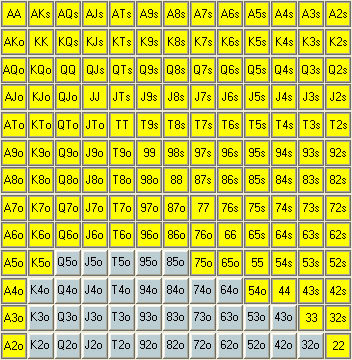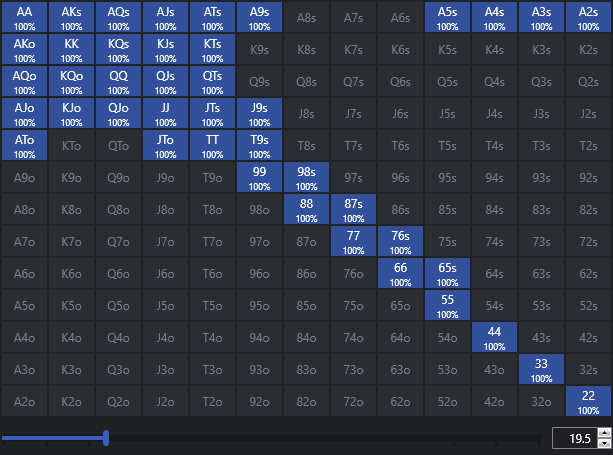Omaha poker pre-flop concept is misused by many players. Pre-flop hands are crucial in Omaha poker and they don't have similar values. Learn how to play Omaha Poker (PLO). Use this beginner's guide to discover PLO rules, basic PLO strategy, and the best Omaha poker games to practice for free! If you're interested in learning how to play Pot Limit Omaha Poker, then our eight-parter strategy guide was written for you! Pot Limit Omaha Poker From Square One consists of in-depth, actionable.
Online Poker » Poker Strategy » Omaha » How to Play Omaha Poker
Omaha Poker Strategy Starting Hands Reaching
Many players who learn how to play Texas Hold'em eventually make their way into learning how to play Omaha Poker. Omaha is very easy to learn as it uses the same structure as Hold'em with the key difference being that each player is dealt 4 hole cards instead of 2.
For those of you that are interested in giving Omaha a shot, here are the rules on how to play.
Omaha Poker Rules
* Before any cards are dealt, the blinds must first be posted. These are required 'forced' bets or antes made by the first two players to the immediate left of the dealer. The first player to the left is known as the small blind and puts out the smaller of the two bets, generally half the size of the big blind. The player to the small blind's immediate left is known as the big blind who posts the bigger of the two bets, generally the size of the current blind.
So for example, if playing in a $3/$6 Omaha cash game, the small blind would be required to post $3 and the big blind would be required to post $6.


* Once the blinds have been posted, the dealer now deals 1 card at a time starting with the small blind and dealing around the table clockwise until each player has 4 hole cards faced down.
* After the cards have been dealt, the first betting round begins with the player to the immediate left of the big blind also known as the player under the gun. The betting options for this round is to fold, call the current bet, which is the size of the big blind, or raise.
Omaha Poker Strategy Starting Hands Chart
Note: Omaha is generally played in a pot limit variation which means that players must raise at least the size of the big blind, but no bigger than the size of the current pot.
Action will continue like this clockwise around the table until all players have folded, called the current bet (big blind or current raise), or have raised. Once the action is on the small blind, the small blind can either forfeit the small bet made prior or match it to be involved in the hand. Since the big blind has already made the minimum bet, this player can then 'check' to see a flop or raise.

* Once the betting round is completed, the dealer will now deal the flop which is the first 3 of 5 community cards that players can use to make a 5-card poker hand.
* The second betting round will begin with the small blind. In the scenario that the small blind folded pre-flop, the betting action will begin with the first active player to the left of the dealer. During this round, players can either 'check' or bet or in the event that a player bets, all other players can fold. Checking simply means that a player wishes to pass on making a bet. It is also possible for all players to check and skip an entire betting round. The betting round is completed once all players have checked, bet or folded with the action typically ending with the player on the 'button' (dealer).
* After the second betting round has finished, the dealer will now turn over the 4th community card known as the 'turn' or '4th street.' Players can use this card along with the flop and their hole cards to make the best 5-card poker hand.
* Now, another betting round begins once again starting with the player on the small blind. Just like the previous betting round, players can check, bet or fold depending on the action that has happened before them.
* Once the betting action is completed, the dealer will then flip over the 5th and final community card known as the 'river' or '5th street.'
* After the river card is dealt, the last betting round will begin. Once again, it will start with the small blind or the closest active player to the left of the dealer. Players will have the option to check, bet or fold.
* After this betting round, the remaining players will then flip over their hole cards and the player with the best 5-card poker hand will win the pot.
* Then the button will move one seat to the left and a new round will start once again from the top.
Omaha Poker Rules Notes
* All players must use 2 of their 4 hole cards in combination with 3 of the 5 community cards to make their 5-card poker hand.
* When playing Omaha 8 or better (hi/lo), players can win one-half of the pot if they have the best 5-card low hand A thru 8 or the best 5-card high hand. It is possible to 'scoop' (win) the whole pot if a player has the best hi/lo card combination or if a low hand is not possible.
* It is not required that players go to showdown. If a player were to make a bet large enough to cause all the other players in the hand to fold on any betting round, the hand will end there and that player will win the pot and not have to show his or her cards.
Omaha Poker Strategy Starting Hands Signals
Omaha Poker
Omaha Poker Strategy Starting Hands Rule
As you can see, Omaha Poker is easy to learn, as the format is almost identical to Texas Hold'em. But once you learn how to play Omaha, you will quickly find out that Omaha is an entirely different game and can be quite challenging to play.